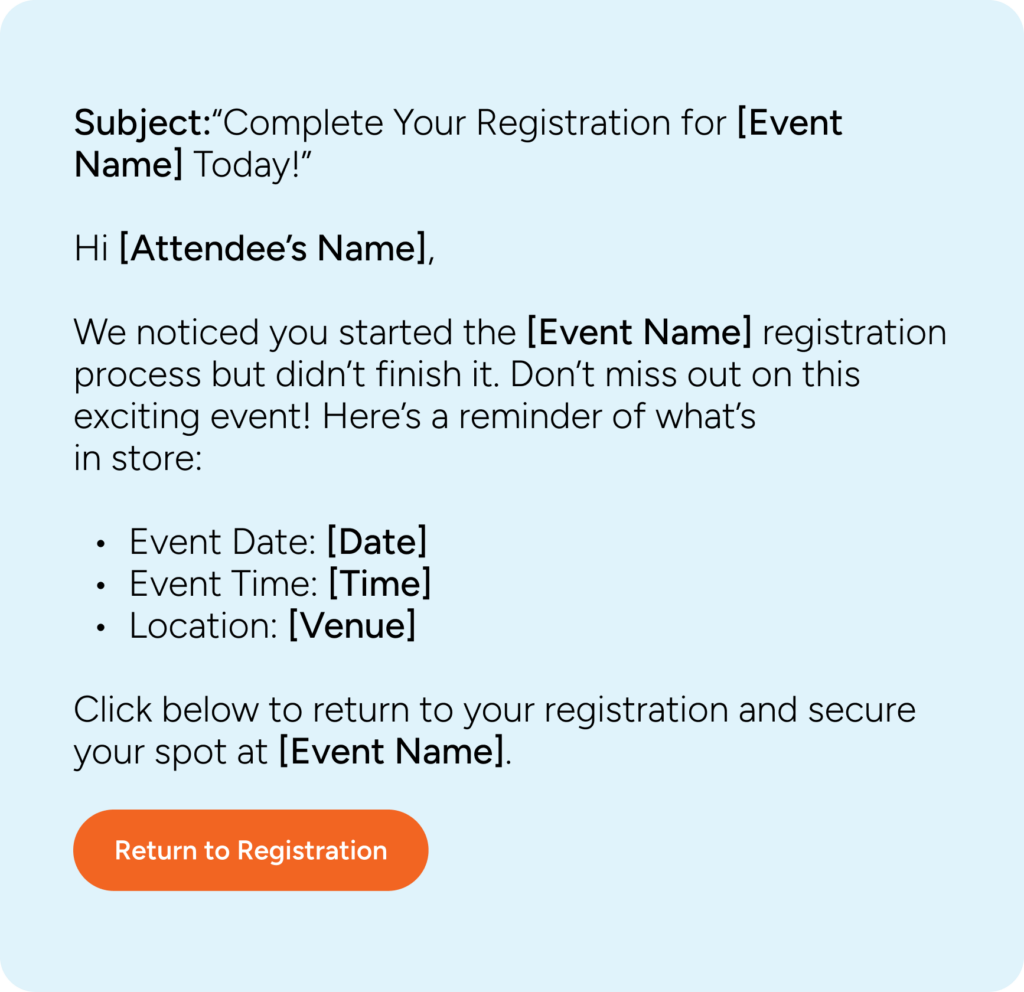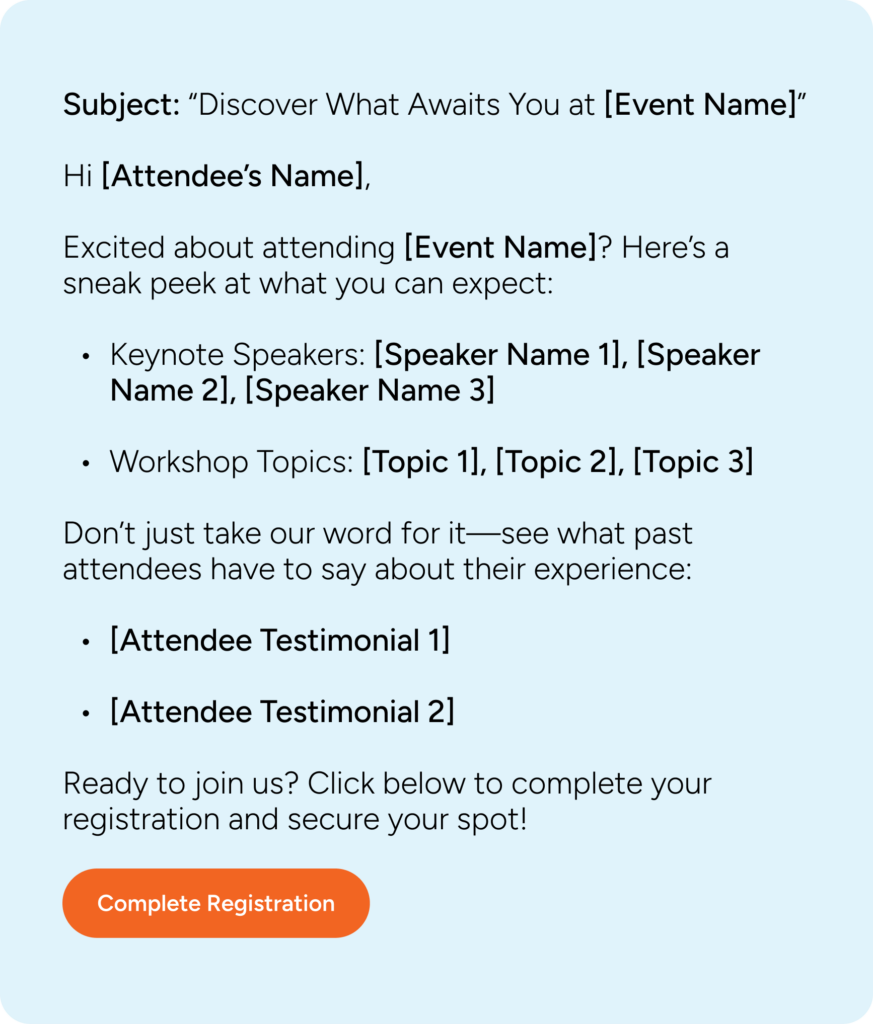Event planners aim to increase revenue, registrations, and engagement in attendee-paid activities. With only three out of 10 people completing an online purchase, understanding how to address abandoned carts and abandoned registrations can elevate your event management strategy.

Source: 49 Cart Abandonment Rate Statistics 2025
Leveraging these cart abandonment best practices and effective recovery solutions will help your event management team maximize ROI and amplify attendee engagement.
What is cart abandonment?
Cart abandonment is widespread. In event management, cart abandonment typically refers to individuals beginning an event’s registration or ticket purchasing process but not completing it. It is also called “registration abandonment” or “abandoned registration.”
Cart abandonment in events management can result in lost revenue and missed attendance opportunities.
Consider tracking cart abandonment rates and analyzing the reasons behind them. Optimizations and tactics such as retargeting and e-mail marketing may help re-engage potential attendees who’ve previously abandoned the registration process.
Strategies to reduce cart abandonment
Don’t want cart abandonment to be such an issue? Prevent it! Understanding why people abandon carts, evaluating where your event registration process can be improved, and implementing those learnings can stop the problem before it starts.
Reasons customers abandon carts
Understanding the reasons behind cart abandonment is crucial for devising effective strategies to combat it.
Customers may abandon their carts due to unexpected fees, complicated checkout processes, comparison shopping across multiple platforms, or getting distracted before completing the purchase. What can your event management team do to lessen cart abandonment?
Simplify checkout
- Minimize steps: How often have you gone to complete a purchase, and you have to click through pages and pages, recover a password, or the checkout times out? Did you continue? Ensuring your process is smooth, as simple as possible, and secure are some of the most definite ways to reduce cart abandonment.
- Clear CTAs: Include clear call-to-action across your site to make it clear where people add registrations and add-ons to the cart. Nothing is worse than searching for a way to pay.
Making paying easy
- Cost transparency: You should not bait and switch people into spending more. Unexpected fees are a significant driver of cart abandonment. Offering transparent pricing upfront and sharing what is included in your pricing may encourage more conversions.
- Security upfront: A secure, PCI-compliant payment processing system protects attendees’ sensitive information and minimizes security risks for organizers. Openly share that you have invested in secure payment processing for the well-being of your attendees.
For a more comprehensive look into How to Market Your Conference, check out our blog post, which covers additional digital marketing strategies, registration optimization, how to maximize early bird discounts, and how to nurture attendee engagement.
Best practices for overcoming abandoned carts: e-mail campaigns
Cart abandonment e-mails are a powerful marketing tool to re-engage with customers who have shown interest in products or services. These e-mails are automated and are sent to encourage customers to return to the website and complete the transaction.
Abandoned cart e-mails offer several benefits, including recovering potentially lost sales and re-engaging with customers who have shown interest in products or services.
Benefits of abandoned cart e-mails
Abandoned cart e-mails can be highly successful in recovering registration, and abandoned cart e-mails typically have higher open and conversion rates.
Here are a few reasons why abandoned cart e-mails are successful:
- The reminder effect: Who couldn’t use a reminder now and then? Abandoned cart e-mails prompt customers who may have been distracted or hesitant during checkout.
- Personalization: Effective abandoned cart e-mails for events often include personalized elements such as limited-time offers tailored to the event’s timeline, event-specific messaging highlighting the unique experience, and recommendations based on the customer’s previous interactions with similar events
- Timing: Timing is crucial with abandoned cart e-mails. Sending the e-mail shortly after the abandonment occurs, typically within a few hours or days, can increase the likelihood of recapturing the customer’s interest.
- Incentives: Offering early bird discounts, VIP access, or other exclusive deals can motivate customers to return and complete their registration.
- Customer engagement: Abandoned registration e-mails provide an opportunity for ongoing communication with customers, allowing event managers to engage with them and address any concerns or questions they may have.
Measuring the success of abandoned cart e-mail campaigns
The success of abandoned cart e-mail campaigns can be measured through various metrics that track the campaign’s effectiveness in recovering lost sales or registrations.
- Open rate: This metric measures the percentage of recipients who open the abandoned cart e-mail. A higher open rate indicates that the subject line and sender name were compelling enough to capture recipients’ attention.

Source: The abandoned cart benchmarks report: 2024 data to inform your strategy
- Click-through Rate (CTR): CTR measures the percentage of recipients who clicked on a link within the abandoned cart e-mail to return to the website or registration page. It indicates the level of engagement and interest generated by the e-mail content.

Source: The abandoned cart benchmarks report: 2024 data to inform your strategy
- Conversion rate: The conversion rate measures the percentage of recipients who complete the desired action, such as making a purchase or completing the registration process, after clicking through the abandoned cart e-mail.
- Revenue or revenue recovery: This metric calculates the total revenue generated from customers who return to complete their purchase or registration after receiving the abandoned cart e-mail. It clearly measures the e-mail campaign’s impact on the bottom line.
- Abandoned cart recovery rate: This metric measures the percentage of abandoned carts recovered from the e-mail campaign. It is calculated by dividing the number of completed purchases or registrations by the total number of abandoned carts.
- Average Order Value (AOV): AOV measures the average amount customers spend after returning to complete their purchase after receiving the abandoned cart e-mail. Increasing the AOV indicates that the campaign is effectively encouraging customers to add more items to their cart or upgrade their selection.
By tracking these metrics and analyzing the results, event planners can assess the effectiveness of their abandoned cart e-mail campaigns, identify areas for improvement, and optimize their strategies to maximize conversions and revenue recovery.
How often should abandoned cart e-mails be sent?
While there is no one-size-fits-all answer, as the optimal frequency can vary based on factors like industry, audience preferences, and the nature of the products or services offered, here are some general guidelines:
- Initial e-mail: Send the first abandoned cart e-mail shortly after the abandonment occurs, typically within the first few hours up to 24 hours after the event. This initial e-mail serves as a timely reminder while the items are still fresh in the customer’s mind.
- Follow-up e-mails: If the customer hasn’t responded to the initial e-mail, consider sending one or two follow-up e-mails over the following days. The timing of follow-up e-mails can vary depending on the urgency of the purchase or registration deadline. Only send as many e-mails as you would tolerate over a short period.
- Testing and optimization: Test different sending frequencies and timing intervals to determine what works best for your audience. Monitor engagement metrics such as open rates, click-through rates, and conversion rates to gauge the impact of different e-mail cadences on campaign performance.
- Segmentation: Consider segmenting your audience based on factors such as purchase history, browsing behavior, or cart value, and tailor the frequency of abandoned cart e-mails accordingly.
- Preference center: Provide recipients the option to customize their e-mail preferences, including the frequency of abandoned cart e-mails. This allows customers to indicate their preferred communication frequency and helps reduce the risk of unsubscribes or disengagement due to e-mail overload.
Establishing the right balance between staying top-of-mind and respecting the recipient’s inbox is key to maximizing the effectiveness of abandoned cart e-mail campaigns. Regularly monitor feedback and performance metrics to refine your e-mail strategy and ensure a positive customer experience.
4 abandoned cart e-mail examples
Let’s look at some real-life examples of abandoned cart e-mails showcasing effective strategies and designs that drive conversion and customer engagement.
Reminder E-mail with Event Details

Subject: “Complete Your Registration for [Event Name] Today!”
Hi [Attendee’s Name],
We noticed you started the [Event Name] registration process but didn’t finish it. Don’t miss out on this exciting event! Here’s a reminder of what’s in store:
- Event Date: [Date]
- Event Time: [Time]
- Location: [Venue]
Click below to return to your registration and secure your spot at [Event Name].
[CTA Button: Return to Registration]
Limited Time Offer E-mail

Subject: “Last Chance! Register for [Event Name] and Save [Discount]%”
Hi there,
Time is running out to secure your spot at [Event Name]! Register now and enjoy an exclusive [Discount]% off your registration fee. But hurry, this offer expires soon!
Click below to complete your registration and take advantage of this special discount.
[CTA Button: Complete Registration]
Event Highlights and Testimonials E-mail

Subject: “Discover What Awaits You at [Event Name]”
Hi [Attendee’s Name],
Excited about attending [Event Name]? Here’s a sneak peek at what you can expect:
- Keynote Speakers: [Speaker Name 1], [Speaker Name 2], [Speaker Name 3]
- Workshop Topics: [Topic 1], [Topic 2], [Topic 3]
Don’t just take our word for it—see what past attendees have to say about their experience:
- [Attendee Testimonial 1]
- [Attendee Testimonial 2]
Ready to join us? Click below to complete your registration and secure your spot!
[CTA Button: Complete Registration]
Assistance and Support E-mail

Subject: “Need Help Registering for [Event Name]? We’re Here to Assist”
Hi [Attendee’s Name],
We noticed you encountered some difficulties while registering for [Event Name]. Don’t worry; we’re here to help! Please get in touch with us if you have any questions or need assistance with the registration process.
We’re looking forward to seeing you at [Event Name]!
[CTA Button: Contact Support]
These examples demonstrate how abandoned cart or registration abandonment e-mail strategies can be adapted for the event management industry, focusing on event details, limited time offers, event highlights, testimonials, and support to encourage attendees to complete their registration and secure their spot at the event.
You can transform lost registrations into confirmed attendees by proactively addressing cart abandonment at every stage—from streamlining your checkout and offering transparent, secure payment options to implementing targeted, personalized e-mail recovery campaigns.
Remember to continuously monitor key metrics to refine your approach, test different messaging and timing, and segment your audience for maximum opportunities.
When you consider prevention tactics and implement smart recovery strategies, you’ll recover lost revenue and build stronger relationships with prospective attendees. The most successful event management teams view cart abandonment as an opportunity to learn, optimize, and engage—elevating the overall attendee experience and driving sustainable growth.

